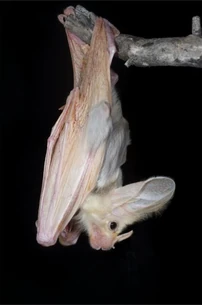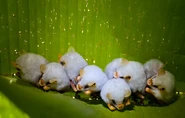
The ghost bat (Macroderma gigas), also known as the false vampire bat is a bat native to Australia. The bat is named for the extremely thin membrane of its wings that makes it appear ghostly at night. Ghost bats have grey fur on their backs and pale grey or white fur on their undersides. They have long, narrow wings, but no tail, averaging 11 centimetres (4.3 in) in length. Females are generally smaller than males. Ghost bats have large ears for long distance hearing, and very sharp teeth so they can attack prey.
Distribution[]
The ghost bat is endemic to the Northern Pilbara and Kimberley in Western Australia, the top end of the Northern Territory, and scattered throughout Queensland. Analysis of fossil remains shows that distribution patterns within Australia changed in waves of both expansion and contraction, and the probable cause was climate change. Populations of the ghost bat have declined from 450 in the 1960s to 150 in the 1980s. The ghost bat gets its common name from its distinct colouring: the predominant shade of fur is a whitish pale grey. Little is known of the genetics of the ghost bat.
Description[]
The ghost bat has an average body length of 100–140 millimetres (3.9–5.5 in) and mass of 130–170 grams (4.6–6.0 oz), making it one of the largest microchiropterans. With ears that consist of nearly half the length of the face, large eyes, and strong curved claws; the lower jaw juts out slightly farther than the upper and houses 26 large, robust teeth. The wing span is approximately 0.6 metres (2 ft 0 in). The overall size of the females is smaller than that of males, although certain body parts, including fingers and tibia, are larger in the female.
Behaviour and Diet[]
Although Macroderma gigas is inactive during daylight hours, they do not hibernate. Buildings may be used as feeding grounds, but the ghost bat only roosts in caves, rock crevices, or mines. The roost is left several hours after sunset either alone, in pairs, or in small groups. Hunting occurs via a sit and wait technique three to five hours after sundown. Although the ghost bat has astoundingly good vision for a microchiropteran, echolocation is utilised to directly locate approaching prey. Once located, the animal is held down via the thumb claws and killed by a single bite to the neck. The ghost bat is carnivorous and commonly feeds on small mice, other bats, small birds, legless lizards, geckos, snakes, and insects. Macroderma gigas is formally referred to as a specialised carnivore, but they have been known to feed on insects if prey is scarce. Vertebrate prey is eaten much more frequently, though, and is usually consumed at the site of capture.
Reproduction[]
During the breeding season, late October to early November, female bats congregate in groups and give birth to a single young. According to a study conducted on range of ghost bats in Australia, “female bats gave birth to a single young in late spring, but only 40% of females bred in their second year, increasing to 93% for females greater than 2 years old”.
Range Decline[]
The ghost bat was once widely distributed throughout Australia, but over the past 10 years, researchers have failed to find evidence of the species in areas it had once inhabited. Recently, it has been discovered that there was an unexplained northern contraction of ghost bats both before and after European settlement in Australia. There are isolated congregations of bats in specified maternity sites in which the alleles expressed by the females are completely different; this implies that the separation of such populations extends through evolutionary time. This scattering into small sets of populations greatly raises the threat of extinction to the species.
Threat of Extinction[]
Although the range of the species has drastically decreased, it is estimated that several thousand ghost bats remain in existence today. The largest threat to the Macroderma gigas is mining in Australia; blasting of caves makes them uninhabitable for the bats. Because of this, declines in population are expected to be reversed in part because of increased survival rates, not because of immigration from other isolated areas. There are very few national parks that strive to protect the species at this time.
